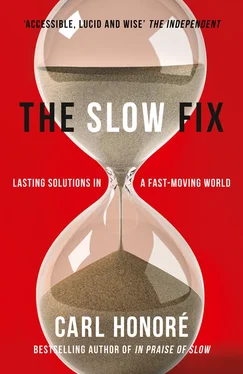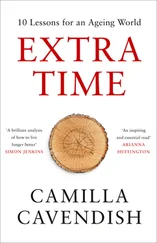System 1 was a good match for life in the distant past. Our early ancestors had less need to ruminate deeply or take the long view. They ate when hungry, drank when thirsty and slept when tired. ‘There was no tomorrow when living on the savannah, and survival depended on what you did each day,’ says Whybrow. ‘So the physiological systems that we inherited in the brain and body focused on finding short-term solutions and rewarding us for pursuing them.’ After farming began to take hold 10,000 years ago, planning for the future became an asset. Now, in a complex, post-industrial world, System 2 should be king.
Only it is not. Why? One reason is that, inside our 21st-century heads, we are still roaming the savannah. System 1 holds sway because it takes a lot less time and effort. When it kicks in, the brain floods with reward chemicals like dopamine, which deliver the kind of feel-good jolt that keeps us coming back for more. That’s why you get a little thrill every time you graduate to the next level in Angry Birds or cross an item off your To-Do list: job done, reward delivered, move on to the next thrill. In the cost–benefit calculus of neuroscience, System 1 offers maximum return for minimum effort. The rush it delivers can even become an end in itself. Like coffee addicts itching for a shot of caffeine, or smokers dashing outside for a cigarette, we get hooked on the quick fix of the quick fix. By comparison, System 2 can seem a dour taskmaster, demanding toil and sacrifice today in return for the promise of some vague pay-off in the future, like a personal trainer barking at us to eschew that chocolate éclair in favour of another 20 push-ups, or a parent nagging us to hit the books instead of running outside to play. Henry T. Ford was referring to System 2 when he said, ‘Thinking is the hardest work there is, which is the probable reason why so few engage in it.’
System 2 can also act like a spin doctor, rationalising our preference for short-term rewards. After yielding to temptation and wolfing down that éclair, we convince ourselves that we deserved a treat, needed the energy boost or will burn off the extra calories in the gym. ‘The bottom line is that the primitive brain is wired for the quick fix; it always has been,’ says Whybrow. ‘The delayed gratification that comes with taking the long view is hard work. The quick fix comes more naturally to us. That’s where we get our pleasure. We enjoy it and soon we want it quicker and quicker.’
That is why our ancestors warned against quick fixes long before Toyota invented the Andon rope. In the Bible, Peter urges Christians to be patient: ‘The Lord is not slow to fulfil his promise as some count slowness, but is patient towards you, not wishing that any should perish, but that all should reach repentance.’ Translation: God is not in the business of supplying real-time solutions. Nor was it just religious authorities that fretted over man’s soft spot for the siren call of short-termism. John Locke, a leading thinker of the Enlightenment, warned that quick-fix merchants were on the road to ruin. ‘He that has not mastery over his inclinations, he that knows not how to resist the importunity of present pleasure or pain, for the sake of what reason tells him is fit to be done, wants the true principle of virtue and industry, and is in danger never to be good at anything,’ he wrote. A century later, Alexander Hamilton, one of the founding fathers of the United States of America, restated the danger: ‘Momentary passions and immediate interests have a more active and imperious control over human conduct than general or remote considerations of policy, utility or justice.’ A distrust of snap decisions lingers even in the modern era. In the face of a dire medical diagnosis, the conventional advice is to seek a second opinion. Governments, businesses and other organisations spend billions gathering the data, research and analysis to help them solve problems thoroughly.
So, why, despite all these warnings and exhortations, do we still fall for the quick fix? The lure of System 1 is only part of the explanation. Over hundreds of thousands of years, the human brain has evolved a whole array of quirks and mechanisms that distort our thinking and nudge us in the same direction.
Consider our natural penchant for optimism. Across cultures and ages, research has shown that most of us expect the future to be better than it ends up being. We significantly underestimate our chances of being laid off, divorced or diagnosed with a fatal illness. We expect to sire gifted children, outperform our peers and live longer than we actually do. To paraphrase Samuel Johnson, we let hope triumph over experience. This tendency may have an evolutionary purpose, spurring us to strive and push forward, rather than retreat to a dark corner to brood on the unfairness of it all. In The Optimism Bias , Tali Sharot argues that belief in a better future fosters healthier minds in healthier bodies. Yet she warns that too much optimism can backfire. After all, who needs regular health check-ups or a retirement savings plan if everything is going to pan out in the end? ‘“Smoking kills” messages don’t work because people think their chances of cancer are low,’ says Sharot. ‘The divorce rate is 50 per cent, but people don’t think it’s the same for them. There is a very fundamental bias in the brain.’ And that bias affects the way we tackle problems. When you slip on the rose-tinted spectacles, the easy quick fix suddenly looks a whole lot more plausible.
The human brain also has a natural fondness for familiar solutions. Instead of taking the time to understand a problem on its own merits, our habit is to reach for fixes that have worked on similar problems in the past, even when better options are staring us in the face. This bias, uncovered in study after study, is known as the Einstellung effect. It was useful back in the days when mankind faced a limited set of urgent and straightforward problems such as how to avoid being eaten by a lion; it is less helpful in a modern world of spiralling complexity. The Einstellung effect is one reason we often make the same mistakes over and over again in politics, relationships and careers.
Another is our aversion to change. Conservatives do not have a monopoly on wanting to keep things as they are. Even when confronted with compelling arguments for a fresh start, the human instinct is to stay put. That’s why we can read a self-help book, nod in agreement all the way through, and then fail to put any of the advice into practice. Psychologists call this inertia the ‘status-quo bias’. It explains why we always sit in the same place in a classroom when there is no seating plan or stick with the same bank, pension provider and utility company when rivals offer better deals. This resistance to change is woven into our vernacular. ‘If it ain’t broke, don’t fix it,’ we say, or, ‘You can’t teach an old dog new tricks.’ Along with the Einstellung effect, the status-quo bias makes it harder for us to break out of a quick-fix rut.
Combine that with our reluctance to admit mistakes and you end up with another obstacle to the Slow Fix: the so-called ‘legacy problem’. The more we invest in a solution – staff, technology, marketing, reputation – the less inclined we are to question it or search for something better. That means we would rather stand by a fix that is not working than start looking for one that does. Even the nimblest problem-solvers can fall into this trap. In the early 2000s a trio of software whizzes in Estonia wrote some code that made it easy to make telephone calls over the Internet. Result: the birth of one of the fastest-growing companies of the 21st century. A decade later the Skype headquarters in Tallinn, the capital of Estonia, remains a shrine to start-up chic, with bare brick walls, bean bags and funky art. Everywhere you look, multinational hipsters are sipping mineral water or fiddling with iPads. On a landing near the room where I meet Andres Kütt, Skype’s young, goateed business evangelist, stands a whiteboard covered in squiggles from the last brainstorming session.
Читать дальше












